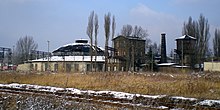Locomotive shed

Roundhouse , locomotive sheds or Lokremise is the name of the lower parking space of locomotives in railway depots or locomotive stations of the railway . There are essentially three designs ; the rectangular shed , the round house and the roundhouse .
In order to be able to carry out maintenance work on the running gear of the locomotives in the locomotive shed , there are often pits under the tracks. Locomotive sheds, in which steam locomotives are heated up (hence the Austrian name Heizhaus ), have a smoke outlet above each track .
Rectangular scales

The simplest design is the rectangular shed, which can be used to accommodate from a single to a double-digit number of locomotives. The rectangular shed is still being built today. Most rectangular scales, which originated in the 19th century, were a course road to drive on. Larger sheds were occasionally provided with a turntable or transfer table in front. In the case of the rectangular sheds, which were built in the course of the state-facilitated branch line construction in Germany from around 1900, this was not necessary because the branch lines normally only operated tank locomotives that did not have to be turned.
Large sheds can also be found in connection with upstream or internal transfer platforms , for example in repair shops or where only vehicles that do not have to be rotated are housed. But there were also box sheds with transfer platforms for steam locomotives , such as in Hagen or Lehrte , with a separate turntable on the site.
Round house

The round house, also known as rotunda , boiler house dome, circular, round or central shed, consists of a circular building in the middle of which is the turntable, around which the sidings for the locomotives are connected in a star shape. The round house has one or more entrances from the outside and is otherwise completely covered. In this way, the turntable was also protected from bad weather. Occasionally, at the beginning of the railway age, the structures were also equipped with a slagging area with a water crane on the approach track. The construction time of the round house was essentially limited to the 19th century. In Germany, the last round house was built in 1893 in Berlin-Pankow with 24 tracks. Round houses were quite common in rail hubs in Europe and North America . With the acquisition of longer locomotives, most of the round houses were given up because they could not be easily enlarged like rectangular or ring sheds. In Germany there are only two round houses (freight yard Berlin-Pankow and in the entrance to the depot Berlin-Rummelsburg , see: Rundlokschuppen Rummelsburg ); the third from last round house was demolished in April 1978 in Paderborn . Other round houses of Prussian design are still in Poland (e.g. the round locomotive shed Piła ), two on the northeast side of the Luxembourg main station and in the former East Prussian Insterburg in the Russian Oblast Kaliningrad (the northern part of the former Prussian province of East Prussia ).
Ring scales

The ring shed is a type of locomotive shed that resulted from experience with the round houses. The circular shed is basically attached to a turntable and built around it like a segment of a circle. Only in rare cases was it possible to get to the locomotive shed tracks with small circular sheds via a switch connection; in these cases a turntable was dispensed with. Today one encounters this situation again with some ring sheds, because the turntable has been removed to save maintenance costs.
In Germany , as a rule, four to six-sided circular sheds were initially built, which were then expanded over the years as traffic increased; often semicircular. In rare cases, two ring sheds were built directly next to each other, or, as in the Hamburg-Altona depot, the two ring sheds were built into a large, almost closed oval, in which originally two close-by, different-sized turntables served the access tracks to the locomotive sheds of different lengths. Later in Altona the two individual turntables developed into two large, interlocking turntables. The engine shed has since been demolished.
In many cases, ring sheds were partially or completely extended to the outside when longer locomotives were located there. They were also rebuilt in the 20th century; for example in the Rheine depot or in 1972 in the Saalfeld depot.
In most locomotive sheds, at least minor repair and maintenance work can be carried out, although larger locomotive sheds also have their own workshop extensions and tracks.
Examples
- Roundhouse Mülheim
- Roundhouse Skierniewice
- Roundhouse Bielefeld
Re-use of old buildings

Numerous (ring) locomotive sheds, which today no longer serve their original purpose, have escaped final disintegration due to conversion into cultural and event centers. Since these buildings often have good acoustics due to their design , they are very suitable for concerts . Known representatives of this group are one of the roundhouse of the former railway depot Augsburg , today Augsburg Railway Park , the Roundhouse in Bielefeld , the engine shed in Rosenheim , the Lokwelt Freilassing as a branch of the German Museum , the Lokremise in St. Gallen , the former engine shed in Klaus an the Pyhrnbahn , the Stammersdorf heating house in Vienna and the Engers depot .
See also
- Locomotive depot (Switzerland)
literature
- Markus Tiedtke: Railway depot. Part 3, turntables and engine shed. (= EK Special , No. 34.) EK-Verlag, Freiburg o. J.
- Bernard Huguenin, Karl Fischer: Ottbergen - Classics of the steam locomotive era. Volume 1: From the beginning to the 1960s. Volume 2: 1970s to today. Self-published by the Modellbundesbahn, 2011, ISBN 978-3-00-033745-1 .


